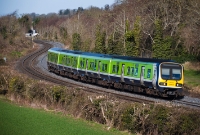Leixlip
Leixlip, on the outskirts of Dublin's western suburbs on the Dublin to Sligo line, is served almost exclusively by Maynooth commuter services. The Midland Great Western Railway built station here is called Leixlip Louise Bridge to distinguish it to the other station located nearer east to the town called 'Confey' dating from 1990. The station at Leixlip was opened in September 1848, but was originally closed in 1947, but retained its loop and signalling until the late 1970s.
In 1981 the station reopened for the new commuter service and a single platform was built on former down line, which was subsequently demolished to allow the re-doubling of the line to Maynooth in 2000 which originally had been singled since 1930 by the Great Southern Railway. Today the original MGWR station building on the down side remains, now a private residence. In 2000 a new booking office was built spanning the tracks at the west end of the station as part of the Maynooth line upgrade.
In 1981 the station reopened for the new commuter service and a single platform was built on former down line, which was subsequently demolished to allow the re-doubling of the line to Maynooth in 2000 which originally had been singled since 1930 by the Great Southern Railway. Today the original MGWR station building on the down side remains, now a private residence. In 2000 a new booking office was built spanning the tracks at the west end of the station as part of the Maynooth line upgrade.
























